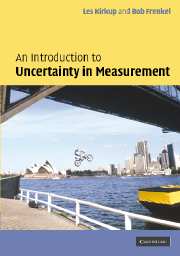 An Introduction to Uncertainty in Measurement
An Introduction to Uncertainty in Measurement Published online by Cambridge University Press: 06 July 2010
In writing this book, we address several groups of readers who require an understanding of measurement, and of uncertainty in measurement, in science and technology.
Undergraduates in science, for example, should have texts that set out the concepts and terminology of measurement in a clear and consistent manner. At present, students often encounter texts that are mutually inconsistent in several aspects. For example, some texts use the terms error and uncertainty interchangeably, whilst others assign them distinctly different meanings. Such inconsistency is liable to confuse students, who are consequently unsure about how to interpret and communicate the results of their measurements.
Until recently, a similar lack of consistency affected those whose primary occupation includes measurement, the evaluation of uncertainty in measurement, instrument and artefact calibration and the maintenance of standards of measurement – that is, professional metrologists. International trade, for example, requires mutual agreement among nations on what uncertainty is, how it is calculated and how it should be communicated; for a global economy to work efficiently, lack of such agreement cannot be tolerated. In the mid 1990s, international bodies, charged with the definition, maintenance and development of technical standards and standards of measurement in a variety of fields, published and disseminated the Guide to the Expression of Uncertainty in Measurement – the ‘GUM’. These bodies included the Bureau International des Poids et Mesures (BIPM) or International Bureau of Weights and Measures, the International Standardisation Organisation (ISO) and the International Electrotechnical Commission (IEC).
To save this book to your Kindle, first ensure [email protected] is added to your Approved Personal Document E-mail List under your Personal Document Settings on the Manage Your Content and Devices page of your Amazon account. Then enter the ‘name’ part of your Kindle email address below. Find out more about saving to your Kindle.
Note you can select to save to either the @free.kindle.com or @kindle.com variations. ‘@free.kindle.com’ emails are free but can only be saved to your device when it is connected to wi-fi. ‘@kindle.com’ emails can be delivered even when you are not connected to wi-fi, but note that service fees apply.
Find out more about the Kindle Personal Document Service.
To save content items to your account, please confirm that you agree to abide by our usage policies. If this is the first time you use this feature, you will be asked to authorise Cambridge Core to connect with your account. Find out more about saving content to Dropbox.
To save content items to your account, please confirm that you agree to abide by our usage policies. If this is the first time you use this feature, you will be asked to authorise Cambridge Core to connect with your account. Find out more about saving content to Google Drive.